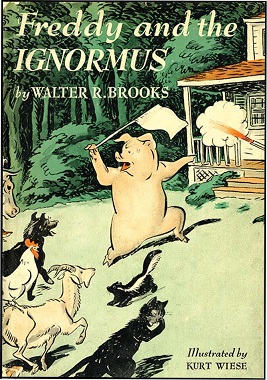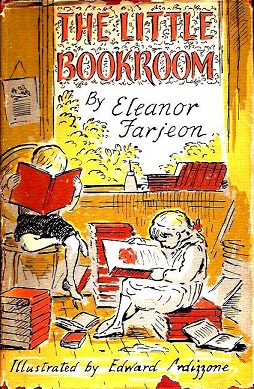This article contains information about the literary events and publications of 1941.

Raymond Redvers Briggs was an English illustrator, cartoonist, graphic novelist and author. Achieving critical and popular success among adults and children, he is best known in Britain for his 1978 story The Snowman, a book without words whose cartoon adaptation is televised and whose musical adaptation is staged every Christmas.

The Adventure Series by Enid Blyton, a prolific English children's author, is a series of eight children's novels. These books feature the same child characters: Philip, Jack, Dinah, and Lucy-Ann, along with several adult characters. Jack's pet parrot, Kiki, is also a standard feature in each novel.

Charles William James Keeping was an English illustrator, children's book author and lithographer. He made the illustrations for Rosemary Sutcliff's historical novels for children, and he created more than twenty picture books. He also illustrated the complete works of Charles Dickens for the Folio Society.
Kathleen Hale OBE was a British artist, illustrator, and children's author. She is best remembered for her series of books about Orlando the Marmalade Cat.

Victor Ambrus was a Hungarian-born British illustrator of history, folk tales, and animal story books. He also became known from his appearances on the Channel 4 television archaeology series Time Team, on which he visualised how sites under excavation may have once looked. Ambrus was an Associate of the Royal College of Art and a Fellow of both the Royal Society of Arts and the Royal Society of Painters, Etchers and Engravers. He was also a patron of the Association of Archaeological Illustrators and Surveyors up until its merger with the Institute for Archaeologists in 2011.
Gillian Rubinstein is an English-born children's author and playwright. Born in Potten End, Berkhamsted, Hertfordshire, England, Rubinstein split her childhood between England and Nigeria, moving to Australia in 1973. As well as eight plays, numerous short stories and articles, she has written over 30 books. Her award-winning and hugely popular 1986 debut Space Demons introduced the themes of growing up and fantasy worlds which emerge often in her other writings. Books such as At Ardilla, Foxspell and Galax-Arena all received critical acclaim and multiple awards.
Ursula Moray Williams was an English children's author of nearly 70 books for children. Adventures of the Little Wooden Horse, written while expecting her first child, remained in print throughout her life from its publication in 1939.
Michael Foreman is a British author and illustrator, one of the best-known and most prolific creators of children's books. He won the 1982 and 1989 Kate Greenaway Medals for British children's book illustration and he was a runner-up five times.
Peter Clover is an English children's book author and illustrator best known for the Sheltie the Shetland Pony series, featuring a young girl, Emma, and her shaggy Shetland pony. In addition Peter Clover has created four other short series: Rescue Riders, Hercules, Donkey Diaries, and Little Bridge Farm, along with numerous standalone titles. The Tale of Blackeye Jax is a ghost story about a phantom highwayman, published by Barrington Stoke who specialise in books for reluctant readers. Dead Cool and Dead Cooler are humorous ghost stories also published by Barrington. His inspiration for the Sheltie pony books camefrom when he used to live on Exmoor in Devon. Peter said, "I wanted to spend my time doing the two things I enjoyed most – writing and creating pictures. Illustrated adventure stories for kids seemed like a brilliant idea and I just love it. Being able to create an entire village like Little Applewood and bringing all the characters to life gave me such a buzz." He is also known for his contemporary abstract paintings and has exhibited in both London and his current home of Mallorca. The Attack of the Killer Frogs is his latest children's horror story, published by A & C Black. With over 70 titles in print throughout UK, USA, France and Germany his latest books are the re-telling of classic tales with ten beautifully illustrated titles including Treasure Island, Robin Hood, Gulliver's Travels, Wind in the Willows, Wizard of Oz, Swan Lake, Rumpelstiltskin and others.
The Blue Peter Book Awards were a set of literary awards for children's books conferred by the BBC television programme Blue Peter. They were inaugurated in 2000 for books published in 1999 and 2000. The awards were managed by reading charity, BookTrust, from 2006 until the final award in 2022. From 2013 until the final award, there were two award categories: Best Story and Best Book with Facts.
Janet Ahlberg and Allan Ahlberg were a British married couple who created many children's books, including picture books that regularly appear at the top of "most popular" lists for public libraries. They worked together for 20 years until Janet's death from cancer in 1994. He wrote the books and she illustrated them. Allan Ahlberg has also written dozens of books with other illustrators.
Mary Treadgold was an English author of books for children and adults, a literary editor and a BBC producer. She won the Carnegie Medal for British children's books in 1941.
Marion Catherine "Kitty" Barne was a British screenwriter and author of children's books, especially on music and musical themes. She won the 1940 Carnegie Medal for British children's books.

Freddy and the Ignormus (1941) is the 8th book in the humorous children's series Freddy the Pig by author Walter R. Brooks and illustrator Kurt Wiese. There are dramatic reports of a monster in the dark woods near the Bean farm. When local animals are subject to extortion, Freddy and his friends test their bravery confronting the unknown.

The Little Bookroom is a collection of twenty-seven stories for children by Eleanor Farjeon, published by Oxford University Press in 1955 with illustrations by Edward Ardizzone. They were selected by the author from stories published earlier in her career. Most were in the fairy tale style.
Gregory John Rogers was an illustrator and writer of children's books, especially picture books. He was the first Australian to win the annual Kate Greenaway Medal from the Library Association, recognising the year's best children's book illustration by a British subject. The book was Way Home by the Australian writer Libby Hathorn, published in the U.K. by Andersen Press in 1994. In the unnamed city, a boy makes his way home at night and adopts a stray cat en route. The "picture book for older readers" was controversial on grounds both that it was "hardboiled" and that it "romanticised the plight of the homeless".
Allen William Seaby Is best known as an ornithological painter and printmaker, and Professor of Fine Art at the University of Reading. He was the author of several art books for students, and also wrote and illustrated books for children.
Jackie Morris is a British writer and illustrator. She was shortlisted for the Kate Greenaway Medal in 2016 and won it in 2019 for her illustration of The Lost Words, voted the most beautiful book of 2016 by UK booksellers. She is a recipient of the Tir na n-Og Award for children's book Seal Children.






